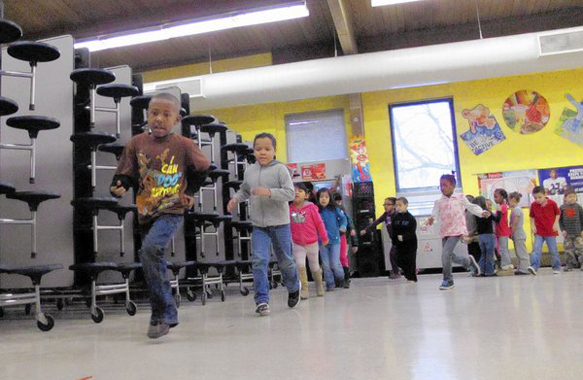Kindergarten students in Kansas City, Kan., run during a physical education class at Frank Rushton Elementary School, which has a high percentage of poor and at-risk children. (John Hanna / Associated Press / January 9, 2014)
Disparities in the public funding of school districts violate the state constitution, and aid must resume by July 1, the Kansas Supreme Court decides.
Wading into a battle being fought in state capitols across the nation, the Kansas Supreme Court ruled Friday that disparities in the public funding of school districts violate the state constitution.
The court ordered Kansas to cure these disparities by July 1 and asked a lower court to evaluate how much the state should be investing in public schools.
It was not quite the slam-dunk ruling that school funding advocates had hoped for; the court did not set funding levels, as a lower court had.
But education advocates, who have been battling the Kansas Legislature on school funding levels for more than a decade, cheered the ruling nonetheless.
“It’s a good day to be a Kansan,” said Annie McKay, the executive director of the Kansas Center for Economic Growth, which advocates for state funding for services.
Read Related Kansas School Funding Is Unconstitutional
Legislatures in many states, including Kansas, began reducing school funding in 2009 during the economic recession. Although methods of funding schools vary by state, many states rely heavily on local property taxes, which causes disparities between poor and wealthy districts. Most states attempt to remedy those disparities by raising state funds to disburse to poorer districts.
As the recession hit, Kansas began to reduce those state payments, making poorer school districts scramble for adequate funding. The reductions in state aid, the state’s high court ruled Friday, “established unconstitutional, wealth-based disparities.”
The lawsuit, Gannon vs. State of Kansas, was filed in 2010 by four school districts and 31 students who argued that the state’s failure to provide “suitable” funding for that education violated their rights to an education under the state constitution.
Kansas countered that increasing school funding did not necessarily improve education quality, and that schools were receiving record amounts of money when federal and other funds were taken into account. In the meantime, Republican Gov. Sam Brownback, who is up for reelection this year, signed into law two rounds of income tax cuts, further frustrating parents who wanted to see more state spending rather than less.
In January 2013, a three-judge panel ruled on the side of the school districts, saying that it was “completely illogical” for the state to cut taxes while blaming an economic downturn for spending cuts. It ordered lawmakers to raise base state aid per pupil to $4,492 from $3,838. The state appealed that ruling.
The Supreme Court on Friday ruled that the school districts had shown that funding reductions hurt their ability to do what the constitution requires them to do: “maintain, develop and operate local public schools.” It ordered the state to resume aiding schools by July 1.
Kansas, which is governed by a conservative Legislature and governor, has been loath to increase spending even as the economy rebounded from the recession.
The state’s general fund will bring in $5.9 billion in revenue in 2014, more than the $5.7 billion it made in 2008, according to data from the National Assn. of State Budget Officers. But it will spend less — $5.9 billion this year, compared with the $6.1 billion it spent in 2008.
According to an analysis by the Center on Budget and Policy Priorities, a Washington, D.C., think tank, Kansas is spending 16.5%, or $950, less per student on education in 2014 than it did in 2008.
Friday’s ruling should, in essence, force the state to stop stalling on school spending, according to Cynthia Lane, superintendent of the Kansas City, Kansas Public Schools, which was a lead plaintiff in the case.
“This decision makes clear that the Legislature has a constitutional obligation to provide equitable funding for all Kansas children,” Lane said in a statement. She said she was confident that lawmakers would “take the necessary steps to fulfill their constitutional obligation.”
Before the ruling, various members of the state Legislature had said they would not comply with any ruling that determined how much they should spend on schools. In his state of the state address in January, Brownback said pointedly that it was the elected representatives of the Legislature, not the courts, who were responsible for funding schools.
But because the ruling does not specify a level of funding, a showdown between the courts and Legislature may not happen.
“We will fix this,” Brownback said at a news conference after the ruling. “My commitment is to work with legislative leadership to address the allocation issue identified by the court.”
The president of the Kansas Senate, Susan Wagle, said she hoped to resolve the issue before the court’s deadline.
This is the second time in a decade that the Kansas Supreme Court has ordered the state to provide more funding to school districts. But the state is by no means the only one where a battle over school funding is raging.
There are lawsuits in 11 states questioning whether state systems deliver an adequate level of funding for all children, said David Sciarra, executive director of the Education Law Center, a group that advocates for public school funding. Those states include California, Connecticut, Florida and New York.
In many states, revenues have rebounded since the recession but school funding hasn’t, Sciarra said. “States are essentially using the recession as an excuse to disinvest in education,” he said.
Copyright © 2014, Los Angeles Times
Further Analysis of the Gannon Decision – Still a Great Decision http://schoolsforfairfunding.org/2014/03/11/further-analysis-of-the-gannon-decision-still-a-great-decision/












Leave A Comment